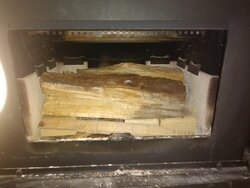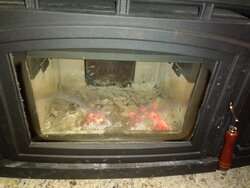I had a Enviro Cabello 1200 installed this summer.
I have been cautiously running it to get a hang of it but keep figuring I could be doing better.
Though I know I have a few things going against me.
1) Insert vs freestanding stove. The blower can only move so much of the heat out of the enclosure to the room.
2) Starting it from cold each evening and in the morning on weekends. So carrying that thermal intertia at startup.
3) Have been worried about burning through too much too early in the season. I have 1 cord of dry wood stacked (moisture meter checked all splits I was cutting to kindling were 16-18% inside at initial split) plus 2 pallets of wood bricks.
My stove seems to draft well (or very well) as it is rarely a challenge to start (door closed and air open until everything is going), and even with damper all the way down the fire keeps going though is showing some reaction to reduced air. Only issue was some wet wood because I was slow to throw tarps over the stack outside in the fall.
With that said I seem to be getting about 2.5-3 hr a load. The amount of heat I get is expectedly somewhat propprional to how I load it. 3 2lb bricks and filling with a variety of sized splits can get fairly toasty but if I just throw in 4 bricks (like this morning) I don't see any noticable change in room temp but it is throwing some medium heat from the blower and radiating from the door.
[Edit: To be clear on this morning, it is 16F out and the oil heat didn't come on while the thermostat says it hovered between 61 and 62 for 2 hours, so it was putting out SOME heat to keep the house temp steady]
So how much do people end up loading up their stove normally? When I put in 8lb worth of wood bricks is that just the equivalent of throwing a pinch of spice into a pot of chili where it is expected to not get much of a noticable result? If I load it up should I expect more burn time because there is less oxygen per cubic volume of wood?
I have been cautiously running it to get a hang of it but keep figuring I could be doing better.
Though I know I have a few things going against me.
1) Insert vs freestanding stove. The blower can only move so much of the heat out of the enclosure to the room.
2) Starting it from cold each evening and in the morning on weekends. So carrying that thermal intertia at startup.
3) Have been worried about burning through too much too early in the season. I have 1 cord of dry wood stacked (moisture meter checked all splits I was cutting to kindling were 16-18% inside at initial split) plus 2 pallets of wood bricks.
My stove seems to draft well (or very well) as it is rarely a challenge to start (door closed and air open until everything is going), and even with damper all the way down the fire keeps going though is showing some reaction to reduced air. Only issue was some wet wood because I was slow to throw tarps over the stack outside in the fall.
With that said I seem to be getting about 2.5-3 hr a load. The amount of heat I get is expectedly somewhat propprional to how I load it. 3 2lb bricks and filling with a variety of sized splits can get fairly toasty but if I just throw in 4 bricks (like this morning) I don't see any noticable change in room temp but it is throwing some medium heat from the blower and radiating from the door.
[Edit: To be clear on this morning, it is 16F out and the oil heat didn't come on while the thermostat says it hovered between 61 and 62 for 2 hours, so it was putting out SOME heat to keep the house temp steady]
So how much do people end up loading up their stove normally? When I put in 8lb worth of wood bricks is that just the equivalent of throwing a pinch of spice into a pot of chili where it is expected to not get much of a noticable result? If I load it up should I expect more burn time because there is less oxygen per cubic volume of wood?
Last edited:



